
Launched for 1951 at the Paris Motor Show of 1950, the 1900 Berlina sports sedan was the car that paved the way for Alfa Romeo back to global success in the post-war years.
After achieving positive recognition, if not a great sales success, with the 6C 2500 series, a carry forward from the Thirties, 1900 was Alfa Romeo's first postwar design. 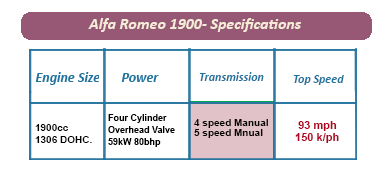 Created by talented in-house designer Orazio Satta Puliga, the 1900 sedan was Alfa Romeo's first car built entirely on a production line.
Created by talented in-house designer Orazio Satta Puliga, the 1900 sedan was Alfa Romeo's first car built entirely on a production line.
 Available initially as either a two-door or four-door sedan, Puliga succeeded in creating a design that was both simple and sporty.
Available initially as either a two-door or four-door sedan, Puliga succeeded in creating a design that was both simple and sporty.
Alfa Romeo were not hesitant in taking advantage of their success on the racing circuits of Europe, marketing that car under the slogan of the "family car that wins races."
![]()
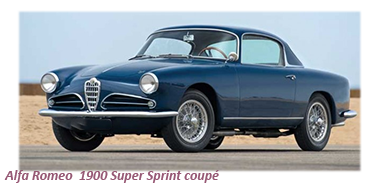
 For those that wanted their 1900 to display a little more zest on the road, late in 1951 Alfa launched the TI fitted with a more powerful 100 bhp (75 kW) engine with a higher-compression ratio and equipped with twin carburettors.
For those that wanted their 1900 to display a little more zest on the road, late in 1951 Alfa launched the TI fitted with a more powerful 100 bhp (75 kW) engine with a higher-compression ratio and equipped with twin carburettors.
With the Italian car industry still in considerable disarray in the early Fifties, Alfa Romeo were among the first to show some interest in innovation, offering the 1900 in a unibody format, a practice which had adopted by UK top-end manufacturers in the Twenties and early Thirties.
![]()
The unibody arrangement meant that the Berlina (sedan) bodies were built at the Alfa Romeo facility, the coupe and cabriolet versions of the 1900 could be farmed out to the local coachbuilders.
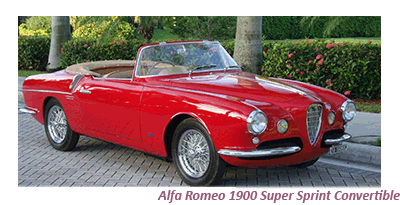 Alfa picked out a number of Italy's renowned coachbuilders for this task, including Ghia, Boano, Bertone. Castagna, Vignale with the Milan-based Carrozzeria coachbuilders being the most in demand.
Alfa picked out a number of Italy's renowned coachbuilders for this task, including Ghia, Boano, Bertone. Castagna, Vignale with the Milan-based Carrozzeria coachbuilders being the most in demand.
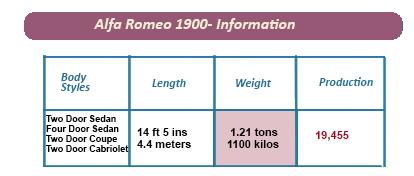 Another bespoke Italian coachbuilder Pinin Farina produced all of the 1900 Cabriolet coupes for Alfa Romeo during the Fifties.
Another bespoke Italian coachbuilder Pinin Farina produced all of the 1900 Cabriolet coupes for Alfa Romeo during the Fifties.
Most of these coach-built coupes and cabriolets were fitted with aluminium bodies.
While each of the few thousand 1900 cabriolets and coupes marketed by Alfa Romeo were ostensibly unique, they did all bear specific universal design characteristics.
These included a narrow triangular centre grille with horizontal bars, flanked by twin air openings, each with a single horizontal bar across its width.Particularly outstanding were the tiny round parking lights that stood below headlamps while car's full rounded wheel openings another interesting design feature.
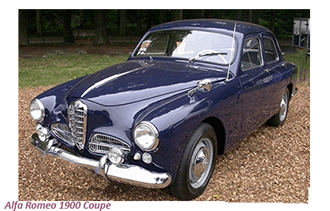 As the Fifties progressed and domestic sales for the 1900 peaked, Alfa Romeo began to turn their attentions to the export market, particularly the UK, where the model was offered with left-hand drive.
As the Fifties progressed and domestic sales for the 1900 peaked, Alfa Romeo began to turn their attentions to the export market, particularly the UK, where the model was offered with left-hand drive.
Of the close to 20,000 Alfa cars made, 17,423 were four-door saloons; the remainder made up from coupes or convertibles.
 Alfa Romeo knew what they were doing when they launched the 1900, aware that while there would be an almost overwhelming demand for a reliable four-door saloon in post-war Italy, the country's upper classes would still be willing to invest in a luxury cart that stood out from the crowd,
Alfa Romeo knew what they were doing when they launched the 1900, aware that while there would be an almost overwhelming demand for a reliable four-door saloon in post-war Italy, the country's upper classes would still be willing to invest in a luxury cart that stood out from the crowd,
With the 1900 Alfa Romeo succeeded in bridging that gap, dovetailing across both market segments.
EU6

